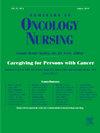Symptom Science in Pediatric Oncology
IF 2.3
4区 医学
Q1 NURSING
引用次数: 0
Abstract
Objectives
to describe the historical evolution of symptom science in pediatric oncology from single symptom measurement to standardizing patient- and caregiver-reported outcomes in clinical trials, including underlying theoretical guidance, contributions of advanced analytics, and the state of integration of the science into clinical practice. Developmental considerations are also described.
Methods
historical and current peer-reviewed literature including original research reports and reviews as well as clinical practice guidelines were reviewed and findings extracted.
Results
Standardized patient-, caregiver-, and clinician-reported symptom and treatment toxicity outcomes are now embedded in certain clinical trials of the largest pediatric oncology cooperative group. Though the 3 reports can be discordant, findings indicate the willingness of patients, caregivers and clinicians to report on symptoms and toxicities. Concurrently, advanced analytics have revealed the existence of patient subgroups in terms of symptom experiences. This latter finding combined with the use of estimated minimally important differences, makes possible the potential of tailoring symptom management. Embedding symptom reports in clinical practice in a standardized manner, including real time reports and care, is a future milestone in pediatric oncology symptom science.
Conclusions
Three symptom perspectives, the patient, family caregiver, and clinician, are essential to accurately measure and manage the impact of cancer therapies on patient symptoms, treatment tolerability, function, and quality of life.
Implications for Nursing Practice
Standardizing patient, family, and clinician reports will provide important research and clinical care advances. Embedding these 3 perspectives in nursing practice in a standardized approach is the next milestone for symptom science in pediatric oncology.
儿童肿瘤的症状科学。
目的:描述儿童肿瘤学症状科学的历史演变,从单一症状测量到标准化临床试验中患者和护理人员报告的结果,包括潜在的理论指导,高级分析的贡献,以及将科学融入临床实践的状态。还描述了发展方面的考虑。方法:回顾历史和当前的同行评议文献,包括原始研究报告和综述以及临床实践指南,并提取研究结果。结果:标准化的患者、护理人员和临床医生报告的症状和治疗毒性结果现在被纳入了最大的儿科肿瘤合作小组的某些临床试验中。虽然这3份报告可能不一致,但研究结果表明,患者、护理人员和临床医生愿意报告症状和毒性。同时,先进的分析揭示了患者亚组在症状经历方面的存在。后一项发现与使用估计的最小重要差异相结合,使定制症状管理的潜力成为可能。将症状报告以标准化的方式嵌入临床实践,包括实时报告和护理,是未来儿科肿瘤症状科学的一个里程碑。结论:三个症状角度,患者、家庭照顾者和临床医生,对于准确测量和管理癌症治疗对患者症状、治疗耐受性、功能和生活质量的影响至关重要。对护理实践的影响:标准化患者、家属和临床医生报告将提供重要的研究和临床护理进展。将这三种观点以标准化的方式纳入护理实践是儿科肿瘤学症状科学的下一个里程碑。
本文章由计算机程序翻译,如有差异,请以英文原文为准。
求助全文
约1分钟内获得全文
求助全文
来源期刊

Seminars in Oncology Nursing
Nursing-Oncology (nursing)
CiteScore
3.40
自引率
0.00%
发文量
68
审稿时长
45 days
期刊介绍:
Seminars in Oncology Nursing is a unique international journal published six times a year. Each issue offers a multi-faceted overview of a single cancer topic from a selection of expert review articles and disseminates oncology nursing research relevant to patient care, nursing education, management, and policy development.
 求助内容:
求助内容: 应助结果提醒方式:
应助结果提醒方式:


